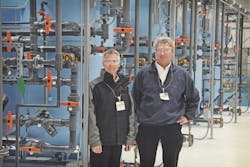Principles of Concentration Difference in Trace Contaminant Removal
About the author:
Kaitlyn Clark is ion exchange technologist for ResinTech. Clark can be reached at [email protected].
The removal of trace contaminants in water depends as much or more on the concentrations of the bulk ions in the water as the concentration of the trace contaminant. The difference between the concentration of the ion exchange resin and the water being treated drives trace contaminant removal more than the trace contaminant’s total concentration in solution. This principle is true, no matter if the trace contaminant is highly preferred (such as uranium and perchlorate) or not preferred at all (such as fluoride or nitrite). In this article, we will explore the principle of concentration difference to explain why the total dissolved solids (TDS) concentration is a larger driving factor in trace contaminant removal than the concentration of the trace itself.
Basic Principles of Trace Contaminants
To illustrate the concept of concentration difference as a main driving force in trace contaminant removal, some simplifying assumptions will be made. Assume that:
- All ions are equally preferred by an ion exchange resin. That is, assume the selectivity is 1-to-1 for any ion with any resin. That is, the selectivity of the contaminant with respect to the reference ion, =1.
- A trace contaminant is defined as a contaminant that makes up 1% or less of the TDS concentration in a water.
- The concentration of an ion exchange resin is approximately 2 meq/L or 100,000 ppm. This is true for a typical strong acid cation resin, but maybe higher or lower for the many various types of ion exchange resin.
- The resin in the examples is nearly 100% in one particular ionic form, which is generally true in single use applications where the resin is not regenerated.
Example 1
Suppose a particular water has a TDS of 100 ppm, and that it contains a trace contaminant, denoted as Ct, that makes up 1% of the TDS. Meaning the concentration of Ct is 1 ppm while the rest of the ions make up 99 ppm of the TDS. For simplification we will assume that all concentrations stated are already on an equivalent basis with one another.
The fraction of resin capacity available to remove Ct = fraction of Ct in the inlet x
1% x 1 = 1%
So, 1% of the resin’s total capacity is available for the removal of Ct. Since the resin’s capacity is 100,000 ppm, the capacity for Ct on the resin is:
100,000 ppm x 1% = 1,000 ppm
This illustrates that a trace contaminant does not need to be highly preferred by the resin in order to obtain significant throughputs. Meaningful throughput may be achieved if the difference in concentration between the water and the ion exchange resin is large regardless of the resin’s preference for a certain ion.
Example 2
Suppose we take the same conditions used in Example 1, but double the concentration of Ct. That is, Ct=2ppm + 99ppm from the other ions, TDS=101ppm.
Fraction Ct in the feedwater ==1.98%
Capacity of the resin for Ct = 100,000 x 1.98%= 1,980ppm
Doubling the concentration of the trace reduces the throughput by only 1%. Thus, throughput capacity is relatively insensitive to the concentration of the trace contaminant.
Example 3
Now, what would happen if the TDS of the water doubled from 100 ppm to 200 ppm while the trace concentration remained at 1 ppm?
% Ct in the feedwater == 0.5025%
Capacity of the resin for Ct = 100,000 x 0.5025% = 502.5 ppm
Doubling TDS reduced the through-put by 50% while doubling the concentration of the contaminant only reduced the through-put by 1%. This shows that the TDS has a much more profound effect on throughput than the concentration of the trace contaminant.
Real-World Considerations
It is important to note that the simplifying assumptions used in the examples cannot be applied in all cases. Many other parameters affect removal capacity in real world scenarios. Some of these include:
- Concentration of the contaminant with respect to the TDS: When the contaminant is present at less than 1% of the TDS, the error is relatively small when using simplifying assumptions to predict capacity. However, as the contaminant level rises to greater than trace concentrations the error from the assumptions becomes too great to predict capacity reliably.
- Apparent selectivity: The simplifying assumptions overlook the relationship between divalent and monovalent ions altogether. The apparent selectivity of divalent ions is concentration-dependent, as such, higher concentrations favor monovalent ions while lower concentrations favor divalent ions.
- The selectivity of the reference ion: When other ions in solution are more preferred than the reference ion on the resin removal behavior changes. At the start of the run, the trace contaminant is removed with the more preferred bulk ion(s), but as the resin becomes saturated with the more preferred ion(s) the relative concentrations and selectivities become a factor to the continued removal of the trace contaminant. In some cases the contaminant will continue to be removed until resin exhaustion but in other cases, the trace contaminant may dump from the resin at a higher concentration than the inlet water.
Conclusion
As illustrated in the above examples, knowing the TDS of a water being treated is extremely important when determining a resin’s capacity to remove trace contaminants. While using the simplifying assumptions may be a good first start at estimating a resin’s capacity for a contaminant, it is always important to consider all factors that affect removal capacity. The most important takeaway from this article is that TDS, the mix of ordinary ions, and the concentrations of those ions are at least as important as the concentration of a trace contaminant itself. As such, the sizing advice a water treatment professional can provide is only as accurate as the water analysis provided to them.
